Archive for November, 2023
Internship in Romania
- Chemistry M.Sc.
- Romania, Bucharest
- National University of Science and Technology Politehnica Bucharest
- 09/2023 – 11/2023
Application & Search for an internship
Romania is home of many inventors and known for its research in many scientifical fields. I am studying chemistry, so naturally I wanted to get to know and experience
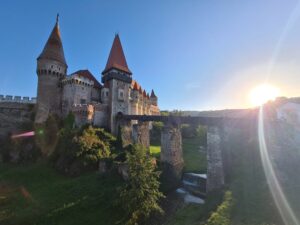
Corvin’s Castle
© Andreea Maria Rânea
the scientifical research in the capital, Bucharest. Since I went for a two-month research internship, the process of applying was different and simpler than going for lectures. I searched for scientific topics of interest and started first looking at University Politehnica of Bucharest, as it has a good reputation. This is how I came across the National Center of Micro and Nanomaterials. My application was done three months in advance, directly to the director of the center, who happily accepted me. As for the bureaucracy, I only had one formular to fill out for my internship to be recognized at RWTH. Romania is part of the European Union, so no visa is required, and if you have a German health insurance, your stay is covered under the European Health Card.
Accommodation & Living Expenses
The University offers all students a place in the dorms, which are near the main campus. In the rectorate, located in the main campus, there is a cafeteria on the top floor (on the terrace) with a look over the campus and with fresh traditional Romanian food. The price of a full meal was around 3 Euros, and you could also have traditional soup for 1.4 Euros. Alternatively, the biggest mall, Afi Palace Cotroceni, is situated 10 minutes on foot from campus, so the possibility of eating at different restaurants can also be taken into consideration.
The University is easily accessible- you can take either the metro, buses, or tram to the University gate. There is a common card which you can use for all these transportation means and the metro fare for example was 1 euro/ 2 trips.
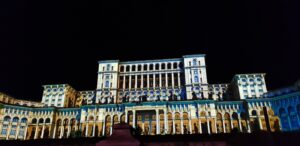
Palace of the Parliament (under light show)
© Andreea Maria Rânea
Groceries are also relatively cheap, so if you wish to cook for yourself, you can find high quality bio vegetables and meat which you can buy directly from the producer. There are many weekly markets with producers from all over the country too.
Everyday life/ Internship
Romanians are generally very welcoming people and usually make it their mission to include new people and make them feel at home. I could feel that especially in my laboratory, where every member would constantly come to me, ask me my progress, if I have any difficulties, if I want to grab lunch together, the list goes on. Even some of them with different expertise and research than mine would sit down with me and brainstorm reasons to explain my results when I needed help. Furthermore, as we sat down one day with the director and another professor, we got to hear stories about their youth and university time, which was quite different from university today. I was surprised to also hear stories about Romanian chemistry figures like Costin Nenițescu and get so familiar with those times. I think it was very nice to befriend the professors and other members like that, instead of only keeping a distanced professional relationship. Going to the laboratory daily felt warm and welcoming.
After I got my safety and general introductions of the laboratory, I could start to work right away. My research was on the synthesis and doping of hydroxyapatite for medical applications. For this synthesis I first used a microwave assisted reactor for hydrothermal method. I also got to personally use the X-Ray Diffraction spectrometer and assist experts for the Scanning and Transmission Electron Spectroscopy. The laboratory was equipped with new generation devices for the best analysis results, as well as all necessary materials for my research. I also got to work again with cells for viability and cytotoxicity tests since my bachelor’s thesis. The bio-safety laboratory was placed in a new building, also on the main campus. From
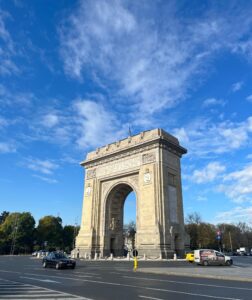
The Triumphal Arch Bucharest
© Andreea Maria Rânea
September to November there was very good weather in Bucharest, with temperatures even exceeding 30 degrees Celsius at times, so the walk through the campus between the buildings was a nice change of scenery during work. With the start of the semester in October it got livelier, also since most students spend their breaks outside (the line in the cafeteria got longer too unfortunately). Another endearing fact was that the group had three aquariums with fish and turtles in the common room, which personally lifted my spirit every day, as the turtles would always come forth to greet you.
During my time there, I was invited to join the Conference of the Romanian Electron Microscopy Society which was held in Cluj-Napoca. This conference was attended by many Romanian and foreign electron microscopy specialists, as well as well-known electron microscope producers like Zeiss, Jeol and Thermo Fisher Scientific. It was a great experience for me, as it was the first scientifical conference of this type that I attended, and it gave me meaningful insights for my future career. Furthermore, I had the opportunity to attend three PhD thesis defenses, also a first for me. The tradition there was that after the presentation, the new doctor would organize a catering for the group to celebrate. There were also a lot of emotions involved and praises coming from the jury, which was formed interdisciplinary, with professors from chemical and medical faculties.
Free Time & Tips
Outside the laboratory I would generally meet friends and walk through the city. We would go down the Victoriei Boulevard and grab some ice cream at one of the best shops I visited (Gelateria La Romana) and then enjoy the George Enescu classical music festival in front of the Royal Palace. Another beautiful sight was the Palace of the Parliament, which is the second largest administrative building after the Pentagon, as well as the heaviest building in the world. The materials used for its construction are almost entirely of Romanian origin, with thousands of tons of crystal and millions m3 of marble, wood, and woolen carpets, as well as velvet and brocade curtains with silver and gold embroideries.

Unirii Square Fountains
© Andreea Maria Rânea
The streets were always full until late, as the shops and restaurants close at 10 PM or later. On Sunday all facilities are open as usual, and you can always find a non-stop shop or even pharmacy. The Old City (Centrul Vechi/ Lipscani) is a glimpse of the old streets of Bucharest, which kept the old buildings and churches as well and is well known as an entertainment center, being home to various restaurants, bars, and clubs. A restaurant that you must visit while in Bucharest is “Caru’ cu Bere”, traditionally decorated and which offers traditional live music as well as traditional dance performances every day. If you are unsure what to order, some typical traditional dishes are “Mici/ Mititei”, “Sarmale”, “Ciorbă de burtă”, “Mămăligă (Polenta) with sour cream and cheese” and “Ardei umpluți”. I also recommend you make a reservation beforehand, if possible, as it is usually very busy. Besides the varied nightlife there are a lot of activities that you can do. Theater is also famous in the Romanian culture, and there are many theaters in Bucharest. I also got to see in premiere the piece “The Envelope” written by famous Romanian novelist Liviu Rebreanu. After the laboratory I would also go to the Dinamo Stadium for track and field training.
On the weekend I traveled to the mountains, to cities like Brașov and Bran, which is known for Dracula’s castle, the Bran castle. Dracula as known today was ins
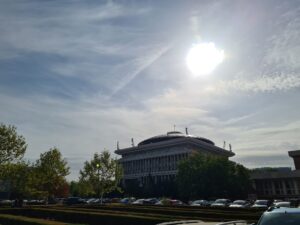
University Politehnica of Bucharest
© Andreea Maria Rânea
pired by Vlad III Voivode of Wallachia, also known as Vlad the Impaler or Vlad Drăculea (Dracula), his first nickname being related to his execution method and the second being his name in the Order of the Dragon. Finally, there were a lot of historical buildings and sites with a lot of stories to tell throughout Romania.
It is important to note that Romania has one of the biggest brown bear populations in Europe, and if you travel to the mountains, you might come across them. If you plan to go on a hike, you must pay attention to the signs and follow the set paths. Also, if you choose a hotel situated in or near the forest, you will get warned by the staff not to walk outside during the night, as you might just encounter one. Sometimes you get to see them from your window too, or on the side of the serpentines, just minding their own business.
In Poiana Brașov you can find two of the best traditional Romanian restaurants, which I totally recommend if you ever visit there.
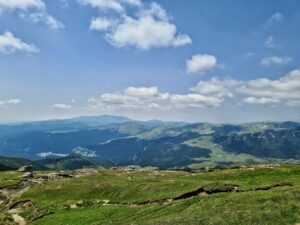
Bucegi Mountains
© Andreea Maria Rânea
These are „Stâna Turistică Serghiana” and „Coliba Haiducilor”. Each has a different charm, and both have traditional live music and decorations. For the first one I recommend to eat outside, at the highest level for the best view, and for the second one inside, for the best atmosphere.
As I said before, Romanians are very welcoming, and you can notice this anywhere you go. Even if you don’t speak the language, the majority of Romanians can speak fluent English and usually other languages as well, like German, Italian, French and Spanish, Romanian also being a latin language.
Conclusion
In conclusion, my research at University Politehnica of Bucharest was a valuable experience for me personally as well as academically and offered me important insights to consider for my future career. Also, there are a lot of stories I could tell about my time there, as my experiences were very varied. The atmosphere is generally very warm and relaxed, and if you plan your research well, you won’t feel too pressured or overwhelmed. I am grateful for being supported during my internship by the Erasmus+ grant and to represent RWTH Aachen University and I definitely recommend a stay abroad in Bucharest as I had a wonderful time there.
Writing a master thesis in Norway
- Molecular and Applied Biotechnology M.Sc.
- Norway, Longyearbyen
- UNIS Svalbard
- 06/2023 – 04/2024
Application/Finding an Internship
The EU project FACE-iT is an international collaboration among several research institutions aimed at studying climate change in Arctic fjords across various trophic levels. Upon discovering the project online, I came across a thesis topic advertised on their website and promptly contacted the responsible professor. Following an online interview, I received confirmation of the suitability of the master thesis project. While the university regularly advertises thesis topics on their website, it’s also beneficial to reach out directly to professors to explore potential topics. Fortunately, I had previous experience with many professors at the University Centre in Svalbard (UNIS) due to my highly recommended bachelor exchange semester there.
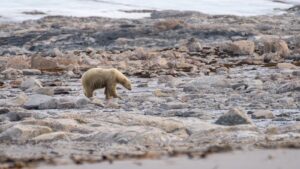
© Lina Lettau
Accommodation & Living Expenses
As a UNIS student, you are automatically allocated housing in the student dormitory, managed by Samskipnaden. Applications can be submitted through their website, offering various options, including a single room with a shared kitchen for approximately 10 people (510€), sharing a room with one other student, or one to two-person apartments with individual kitchens. Living expenses in Longyearbyen are on par with mainland Norway, making them approximately double the cost of living in Germany. The local supermarket impressively stocks a wide range of fresh fruits and vegetables for those who can afford them.
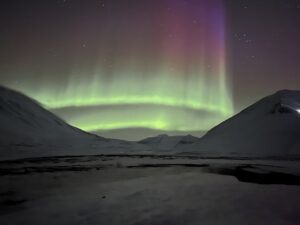
© Lina Lettau
Given the town’s small size, there aren’t many other ways to spend your money (except for drinks at one of the four bars), so most of my expenses went towards food and outdoor equipment.
Everyday Life/The Internship
My internship focused on marine molecular ecology, leading to a varied daily routine. This ranged from boat samplings in the summer to molecular lab work in the autumn, and data exploration during the polar night. Fieldwork days can be quite extensive from my experience. Nevertheless, the average Norwegian workday appeared to be a standard 9 to 5, except when the skies cleared after an extended period of overcast weather. In such cases, the department would empty as everyone ventured out for skiing or hiking. In terms of social life, if you come to Longyearbyen thinking you’re at the end of the world and should lead a hermit-like existence, think again. You’ll be living in student housing with approximately 200 people, and activities like hikes, ice climbing, skiing, snowmobile tours, games, dinner parties, knitting, puzzles, and movie nights are popular. Weekends were often spent in rural cabins outside of town.
Free Time/Tips
Two months before:
Ensure your passport is up-to-date. No visa is required, but you’ll be traveling outside of the EU.
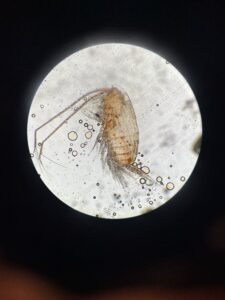
© Lina Lettau
Book your flights with SAS or Norwegian; if you’re under 26, they offer youth discounts.
Apply for a certificate of good conduct (Fuehrungszeugnis) in English and bring it with you. Guns are carried for polar bear protection outside of town, and you’ll receive rifle training upon arrival (no prior experience needed).
Two weeks before:
Stock up on items that might not be available or could be expensive in the one and only super market Longyearbyen. For me, this included tea, dried soy and seitan, drawing supplies, batteries, tech equipment, toiletries, fairy lights, analog photo films, guitar strings, and hair scissors.
Join all relevant Facebook groups, as Longyearbyen heavily relies on them. The most important ones include Ros & Info Longyearbyen (providing information on ongoing events and occurrences in town), Kjøp/salg/bytte/gi bort – Longyearbyen (an online second-hand marketplace), and Svalbard studies spring/autumn semester 20XX (with “XX” representing the year, depending on when you are here).
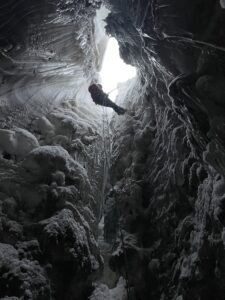
© Lina Lettau
Upon Arrival:
Explore Bruktikken, a donation-based free shop with a diverse range of items, including clothing, books, equipment, decoration, electronics, and more. You can even find second-hand bedsheets and towels there, so don’t overpack. Pro-tip: Work there and sort through the latest donations for yourself while earning money.
Become a member of Svalbard Turn to access the gym, swimming facilities, climbing, and various social sports.
Attend Sprakcafe on Mondays in the library to practice Norwegian while mingling with locals in town.
I also warmly recommend thoroughly reading the UNIS website section on Arrival and living in Longyearbyen – UNIS.
Conclusion:
My research experience at UNIS in Longyearbyen was a valuable opportunity that deepened my understanding of climate change in the unique Arctic ecosystem of Svalbard. Natural sciences and the great outdoors converge in a way that few other places on earth offer.
Internship in Paris
- Architecture B.Sc.
- France, Paris
- LAN Architecture
- 04/2023 – 10/2023
After finishing my bachelor’s degree in Aachen, I planned to do an internship in an architecture firm in Paris.

© Anthony Feghali
Reworking my portfolio was time-consuming because I had to translate all the texts into French. I would recommend anyone who has to submit similar application documents to plan enough time for this.
The internship search turned out to be relatively relaxed at first, as I received feedback quickly and didn’t have
to send out too many applications overall.
I had 2 interviews that were promising. What was particularly exciting was that I hadn’t spoken French for
a long time, especially I didn’t know business French. So I spent the week before the interviews talking to
myself, in everyday life to warm up again.
The two offices I liked gave me more or less a commitment in the interview, I just had to get back to them
and confirm. With this information in mind, I decided to opt for one of the offices and wrote to them, but
they replied that they didn’t have the capacity for it at the moment. The second office I wrote to did not
answer me for quite some time, while the time was getting closer and I had to look for flats.
I took a month to look for a flat. It’s difficult to plan longer in advance as most listings are uploaded quite
spontaneously. My cousin living in Paris helped me to find out which neighbourhoods are preferable and
what prices are reasonable. In a city like Paris, there are a lot of flat ads but also a lot of scams, so you
should be especially careful. After I had been looking on the usual platforms for a while, I searched for
ads in Paris on ‘ WG-gesucht’, a German flat platform, and actually found something. German tenants in
Paris often advertise there for possible new tenants. So I finally came across a very nice couple in their
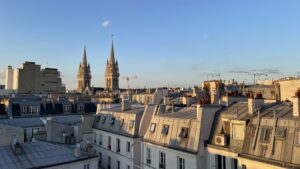
© Anthony Feghali
40s. They both work either in the theatre or in the film sector and therefore know a bit about the cultural
scene in Paris.
My room was about 12 square metres in a 55 square metre flat, which was relatively spacious by Parisian
standards. With a rent of 760€ per month, I was around the upper average. The flat was in the 19th
arrondissement, inside the ring road near the Parc de La Vilette, Paris’ largest park. This neighbourhood
is very well connected and, with its location by the canal and between two large parks, is in a not so
densely built-up area, which is very nice for walking or jogging. It took me no more than 20 minutes by
bike to get to work, and I could ride along the canal.
My employment at LAN Architects lasted 6 months. This office consists of about 25 employees aged
20-40.When I arrived and for the first few weeks I was shocked. There seemed to be a strict and tense
atmosphere in the air. My colleagues were very much among themselves and it was relatively difficult to
get access to them.
The office was largely made up of Italians, as the boss is Italian, which unfortunately often resulted in
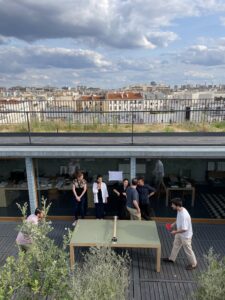
© Anthony Feghali
groupings and conversations in Italian that were hard to follow. I was also not used to their working
hours. A normal day started at 10 a.m. and ended between 7 and 7:30 p.m., sometimes longer or shorter.
Although everyone had a contractual working time of 35 hours a week, they worked overtime every day,
which was rarely recovered. As a trainee, I tried to stick a bit more to the 35 hours, but this didn’t always
work, especially in the beginning. So for the future, I would recommend that aspiring interns clarify the
working hours in advance or any arrangements for overtime. What I had difficulties with in my day-to-day
work were the long hours at my desk. From my studies, I was used to taking my breaks in such a way
that I always had something to move around, but in the office this was not so common.
Gradually, relationships in the office became more relaxed and I began to integrate myself more and
more. This was helped by the office parties that were organised when staff left. Unfortunately, there was a
high fluctuation of staff, as the working environment was not easy, especially with the two bosses. I later
learned that the office is known among architects for having a high work pressure with strict bosses.
So we often went out for a drink after work or did something with some colleagues at the weekend.
Unfortunately, the best time I had with my colleagues was at the end of the internship when it was time to
leave. But that’s probably how it is when you’re there for a short time. The office was planned and built by
the managers. It had a perfect location in the 11th arrondissement on the top two floors with a roof
terrace, so you could eat lunch with a beautiful view over the Parisian mansard roofs.
Since France, unlike other countries, has national regulations for internships, and these can only be
completed as school internships, the pay is also lower than in neighbouring countries. My salary was
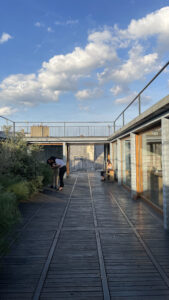
© Anthony Feghali
around 550 € per month. With the Erasmus grant, which was about the same, I had 1100 a month at my
disposal, as my parents paid for my room. I got by on 800 euros a month. The cost of living in Paris is
very high.
This applies to supermarket shopping, restaurants, bars and snack bars. For example, a pint of beer
costs around 8 euros in a traditional pub, and 10 euros in a restaurant. So you couldn’t always afford to
go out for a drink, or you knew the special low-priced bars.
During the working day, I also tried to cook for the week, but that didn’t work for all days, because after
the late end of the working day, you also wanted to have time for leisure and not have to cook again
immediately. But since eating out often cost just as much as eating out in the supermarket, it was worth it
if I was unable to cook. It must also be said that half of the French capital consists of great restaurants
and brasseries that are part of Parisian culture.
One reason that brought me to Paris was the city’s cultural heritage and offerings. I often spent my free
time in the beautiful museums or libraries of Paris or at events such as concerts, jazz evenings or with
friends in the cafés of Paris. I tried to explore a new place or visit a new museum every week. However, I
can say that I only saw a fraction of the city, as it is so rich in things to do and beautiful places to see. At
the same time, you like to revisit places you already like. So it’s a balance act between discovery and
relaxation.

© Anthony Feghali
I would recommend to anyone who is there for a longer period of time not to use the metro and instead
take the bike, and every now and then after work or on weekends try different routes and see where it
takes you. It’s guaranteed that if you keep your eyes open curiously, all sorts of different scenes will
reveal themselves.
I could probably write pages and pages about the city, and about my time here, because the experience
here is very varied. It wasn’t just enthusiasm, but varied from fascination to frustration about the cramped
living conditions, the density or the hustle and bustle of this city. This is probably also part of the Paris
experience. I can recommend a stay here to anyone who speaks some French and is interested in
culture, cities or people. I learned and understood a lot about myself in the confrontation with this way of
life here. Even though I know that I don’t want to live here forever, this time was very special and I would
repeat it.
Research stay at Georgia Institute of Technology
- Aerospace Engineering M.Sc.
- USA, Atlanta
- Georgia Institute of Technology, Aerospace System Design Laboratory (ASDL)
- 05/2023 – 09/2023
Application and Preparation
There has been a long-standing relationship between the Institute of Aerospace Systems (ILR) and the renowned Aerospace System Design Laboratory (ASDL) in Atlanta. Due to my activities as a bachelor student and as a student assistant for many years at ILR, I was given the unique opportunity to spend a research period at ASDL and to work there. The cooperation exists between the professors at both institutes.
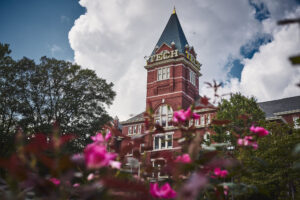
Tech Tower of Georgia Institute of Technology
© Johannes Götz
In November 2022, I started planning and approached ILR about my desire to go there. Due to the choice of my area of work – the ASDL has six great research branches – the visa issuance and the related working documents took a few months. In May 2023, I could already start working remotely and got to know the team. From July until the end of September, I was on site at the Laboratory and worked there as a research assistant. Since I worked in a project belonging to the Defense & Space division, I had to wait some time for my DS-2019 (important work permit).
Accommodation and Living Situation in Atlanta
Finding housing in Atlanta is proving to be difficult. You must be careful at what time you are there because the semester times are very different from ours. In the summer, it is relatively easy to get an apartment for subletting. Facebook groups are excellent for this purpose. However, as always with such portals you must be warned of potential scammers. I first moved into a shared apartment and later into an Airbnb because the semester starts again at the end of August and the apartment search is extremely difficult then. The rental costs are at least about 1500$ per month. Georgia Tech supports you with the purchase of a monthly ticket for the local bus and train transport, called MARTA.
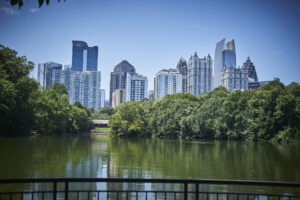
View of Atlanta Midtown from Piedmont Park
© Johannes Götz
These cost $66 per month and the network is well developed by American standards. From time to time, buses and trains are cancelled, but with the appropriate apps and enough scheduled time, I had no problems moving freely in Atlanta and the surrounding area. At night, however, you just must watch out and always be aware of your surroundings. Atlanta can be dangerous at night but also very beautiful. Common sense is highly recommended here and in case of emergency, you should always use services like Uber or Lyft. On Georgia Tech’s campus, there are several bus lines that make regular stops during the week, so it’s easy to get anywhere. I don’t recommend biking because of the traffic and the heat in the summer, though of course it depends on how far away you live.
The Work
I was working in the Defense & Space division on a project that dealt with the active removal of space debris and developed corresponding systems. My activities included work with complex FEM software, simulation of spacecraft control and simulation of the satellite systems and practical tests on tensile testing machines as well as larger test environments for validation and verification of the performed simulation work. It was a joint project between different laboratories and research institutes. NASA engineers were consolidating every couple of weeks. Various other institutions were involved in the project besides the
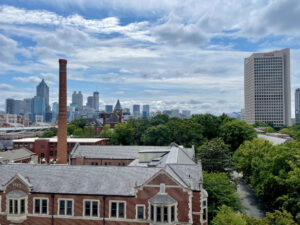
View over south campus from Georgia Tech’s library. Left side view is Downtown, right side is the Coca-Cola headquarter.
© Johannes Götz
Aerospace System Design Laboratory. The most important were Georgia Tech Research Institute, Space System Design Laboratory, various NASA labs, and Georgia Tech’s College of Design. Because of this diversity of partners, meetings were always necessary to keep each other up to date. I worked together with 8 other Graduate Research Assistants. In parallel to my work, I was still working on the DLR Design Challenge remotely. My working hours were 9am-5pm and I spent every day at the institute but was also able to work from home at times. The project does not fall under US export control yet, which made it possible to work in this sector as a foreigner. So, it was a unique opportunity to get to know US work in the space sector.
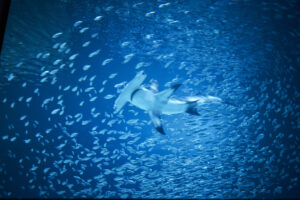
Georgia Aquarium is one of the largest aquariums in the world. A must-see!
© Johannes Götz
Free Time and Tips for Atlanta
Atlanta offers a wide range of activities, all of which are accessible by bus and train. Besides the famous attractions like the Georgia Aquarium, Hall of Fame College Football, the World of Coca-Cola and the huge Mercedes-Benz Stadium, there are also beautiful parks. Take a walk through the Botanical Garden or visit the photo spot in Piedmont Park overlooking the Midtown skyline. Many series and movies have been filmed in and around Atlanta, including Stranger Things and The Walking Dead. Some movie locations exist in reality and can be visited. A trip to Hawkings Lab from the series Stranger Things, for example, was very memorable. At the Mall of Georgia, movies are shown in real (!) IMAX format. A trip there to see Christopher Nolan’s Oppenheimer was very worthwhile. A trip to Buckhead to visit the design and art museums and see the town there is also ideal for spending free time. For American football, field hockey or – the Americans call it soccer – football fans, there is a wide range of things to do, and watching an authentic football game at Mercedes-Benz Stadium was an unforgettable experience. For connoisseurs and lovers of the famous Rocky Horror Picture Show I can only recommend to experience it with authentic disguises and get a quasi-4D cinema show.
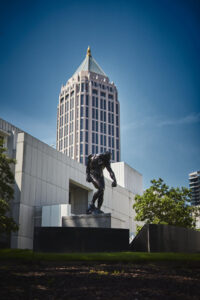
High Museum of Art in north Midtown
© Johannes Götz
The food scene in Atlanta is diverse and a culinary feast for the eyes. Excellent fried chicken, barbecue and coffee shops make you forget the hot summer temperatures there. Rooftop pool parties and cooking together as well as barbecuing together were also part of the everyday unwinding after work.
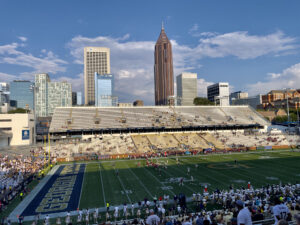
Typical college football game at GT’s home stadium. Go Yellow Jackets!
© Johannes Götz
Conclusion
My research stay in Atlanta was a great enrichment for me personally and an optimal opportunity to apply what I had learned at RWTH and to actively participate in a professional work environment. In addition to the linguistic education, I was able to learn a lot of positive things about American culture. There, a healthy competitive spirit, and a positive attitude towards passionate ambition prevail. These attributes are much more practiced in the U.S. than I thought. The idea of a life’s dream or achieving a good life’s goal is strong there. The students see themselves together in a team, and they also encourage each other to overcome difficult phases in life. I will carry this optimistic and motivating attitude forward. It is a great opportunity for a RWTH student to be able to do such research stays and to represent RWTH and Germany abroad.

